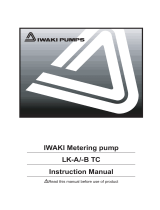
Table of contents
1
Identity code.................................................................................... 5
2 Safety Chapter................................................................................. 8
3 Storage, transport and unpacking................................................. 15
4 Overview of device / control elements........................................... 17
5 Functional description.................................................................... 18
6 Assembly....................................................................................... 19
7 Installation..................................................................................... 23
7.1 Installation, Hydraulic............................................................ 23
7.1.1 Basic installation notes....................................................... 26
7.2 Installation, Electrical............................................................ 28
8 Decommissioning and Disposal.................................................... 35
8.1 Bleeding the liquid end.......................................................... 38
8.2 Calibrating the Stroke Control Drive (Optional)..................... 39
9 Maintenance.................................................................................. 40
10
Repairs.......................................................................................... 46
10.1 Replacing the diaphragm.................................................... 47
10.2 Repair the Diaphragm Rupture Sensor............................... 51
10.3 Calibrating the Capacity...................................................... 53
10.4 Replacing the Power End Bearing...................................... 54
11 Troubleshooting............................................................................. 55
12 Decommissioning and Disposal.................................................... 59
12.1 Decommissioning................................................................ 59
12.2 Disposal.............................................................................. 60
13 Technical Data............................................................................... 62
13.1 Performance Data............................................................... 62
13.2 Metering reproducibility....................................................... 63
13.3 Viscosity.............................................................................. 64
13.4 Weight................................................................................. 64
13.5 Wetted Materials................................................................. 64
13.6 Ambient conditions.............................................................. 64
13.6.1 Temperatures................................................................... 64
13.6.2 Air humidity...................................................................... 67
13.6.3 Installation Height............................................................. 67
13.7 Housing Degree of Protection............................................. 67
13.8 Motor Data.......................................................................... 67
13.9 Diaphragm Rupture Sensor................................................ 68
13.10 Pressure Limitation Valve (HP4)....................................... 69
13.11 Pressure Switch (For Signalling Overpressure)................ 69
13.12 Stroke sensor.................................................................... 70
13.13 Heating cartridge............................................................... 71
13.14 Protective temperature limiter (ATEX only)....................... 71
13.15 Filling volumes.................................................................. 71
13.15.1 Hydraulic oil.................................................................... 71
13.16 Sound pressure level HP4a.............................................. 72
13.17 Supplement for modified versions..................................... 72
14 Ordering Information...................................................................... 73
14.1 Exploded view of the drawing............................................. 73
14.2 Spare parts kits................................................................... 73
14.3 Diaphragms......................................................................... 75
14.4 Pressure relief valves.......................................................... 75
14.5 Pressure switch................................................................... 75
Table of contents
3




















